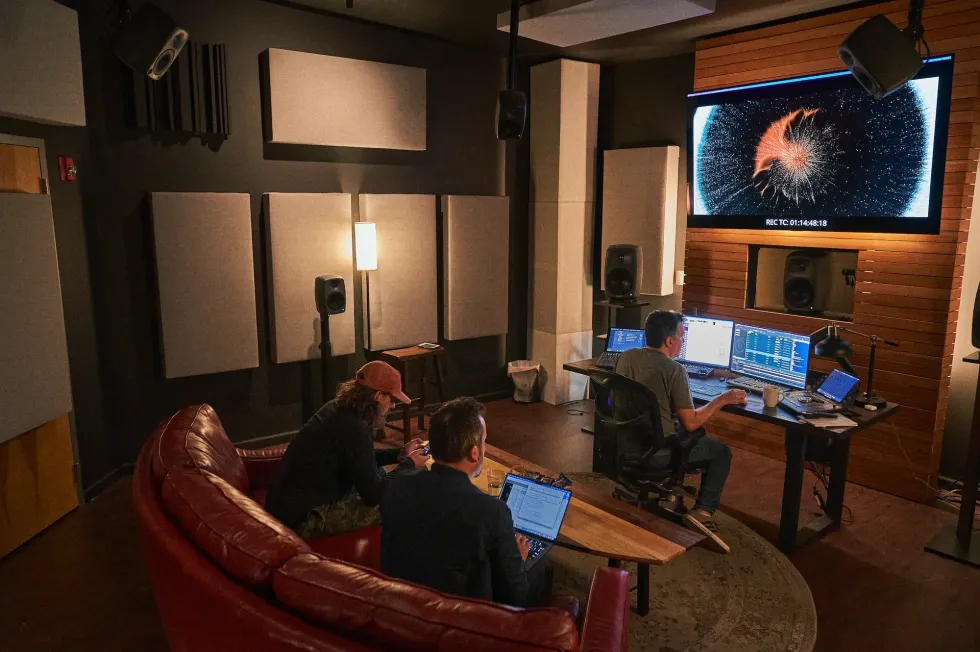Telling the untold story of war and football in “Lions of Mesopotamia” using Premiere Pro and Frame.io
“Lions of Mesopotamia” tells the story of the Iraqi national soccer team’s journey to claim victory in the Asia Cup in 2007 during the bloodiest days of their country’s civil war.

This post was written by Michelle Gallina and originally appeared on the Adobe blog on March 18th, 2024.
Facing violence and division, this documentary shows how the team, made up of Sunni, Shia, and Kurdish players — the sons of enemies battling in a bloody war — achieved the unimaginable: uniting their country during its darkest days.
Editor Lucas Harger used Premiere Pro to tell the deeply personal journey of the players through this captivating documentary over a decade later. Also leveraging Frame.io — a tool he uses extensively — Harger facilitated seamless collaboration, sending assets to collaborators, review links for the director, presentation links for sales and distribution purposes, and more.
Debuted at SXSW this year, “Lions of Mesopotamia” tells the untold story of war, football, and redemption. Continue reading for more behind the scenes insights with Lucas Harger.
How and where did you first learn to edit?
Hacking programs and through trial and error. Growing up, I always had an affinity for editing. I lived in Michigan and there was a vibrant wakeboard community there. My friends all needed sponsorship videos so I would shoot and cut little, 3-5 min videos. Wakeboarding videos back then always had a narrative thread. So early on, I was all about flash and stories. It was a great medium to play in. From there, I creatively wandered and played around in pretty much every digital media medium you can think of — with editing always being home base.
How do you begin a project/set up your workspace?

At Outpost, we have templates for both finder level project management and Premiere/bin management, so set up is never more than a couple clicks away. Workspaces are our passion and pride. Each editor has their own room and setup. Having a dedicated room and creative environment is a must for me. Everything about my setup is there to elicit and maintain creative flow and high level of focus. Anything that detracts from flow and focus is tweaked.
What were some specific post-production challenges you faced that were unique to your project? How did you go about solving them?
There were a lot of translations and subtitles in this film, so utilizing the essential graphics panel and the subtitle track was huge. I love how you can globally change the style and position now with the captions track. Along with that, word searching in the text window was huge. While collaborating with the director, I could navigate the interviews effortlessly.
What Adobe tools did you use on this project and why did you originally choose them? Were there any other third party tools that helped enhance your workflow?
The main tool for us is Premiere Pro — that’s what Outpost is built on for editorial work. Within Premiere Pro, I use quite a few third party plugins, with Excalibur being one of the most frequently used. Integrating Excalibur and Stream Deck will change your life. I also use (shameless plug) PostNotes a lot. I leave myself notes and reminders connected to specific sequences regularly. Part of the momentum, for me, while working on a feature documentary is walking away for the day when you still want to do just a bit more. That way, by the next morning, you are primed, ready, and know where to start for the day. PostNotes is my go-to for that workflow.
Do you use Frame.io as part of your workflow? If so, how do you use it?
We use Frame.io extensively — in both commercial work and original content. For this particular project, it was used for sending assets around to collaborators, review links for the director, review links for the language and cultural advisor, and finally, for presentation links used for sales and distribution purposes.
If you could share one tip about Premiere Pro, what would it be?
Keep your project light, tidy and clean. Cleanliness is next to godliness, after all.
Who is your creative inspiration and why?
I wouldn’t say who, but what. I find a lot of inspiration from poetry, specifically how it relates to editing. I find poetry to inspire tone and rhythm a lot. And beyond that, the poetry I love the most looks for the simplistic path to exploring the deepest emotion. There’s a lot of complexity in the simplicity of poetry and I strive to aim at that in my editing.
What’s the toughest thing you’ve had to face in your career and how did you overcome it? What advice do you have for aspiring filmmakers or content creators?
There’s a misconception that talent exits on the coasts…period. Now, that notion was under pressure and started to crack pre-COVID, but now, there's a realization that talented people are in fact, everywhere. Your skill, craft, and art are not made magically better by being in LA or New York City. Overcoming that instinct early on was definitely a challenge, but I knew that intentional relationships, doing good work with good people, and doing what I said I would do when I said I would do it, would overcome the small minded notion that talent exists in two cities. I know it sounds rather comical at this point, but four years ago, I can tell you it was a real thing.
What’s your favorite thing about your workspace and why?
The people and our collaboration. This space has been designed to elicit creativity as well as collaboration. Without those, the work would be diminished greatly. Having a consistent community of collaborators, and by “consistent” I mean “daily” — we learn each other's quirks and shortcuts. And by “collaborators,” I’m referring to other editors, sound designers, color, story producers and more. We can call on each other to do better and be better. Beyond the work, it’s about the process. The process must be as good, if not better, than the end product. Day in and day out. And our studio seeks to be a conduit for that.
This post was written by Michelle Gallina and originally appeared on the Adobe blog on March 18th, 2024.
- Taking Horror into the Silent Era with SXSW's 'Azrael' ›
- Alex Garland Talks About Shooting ‘Civil War’ on the DJI Ronin 4D at SXSW ›
- Dev Patel Talks ‘Monkey Man’ and Action Cinema at SXSW 2024 ›
- Daniels Talks AI and How They Pulled Off ‘Everything Everywhere All at Once’ at SXSW ›
- Exploring the Cameras Behind the 2024 SXSW Film & TV Festival ›
















